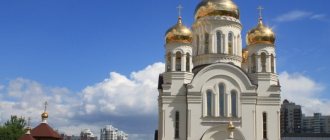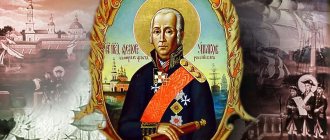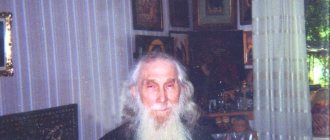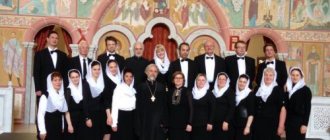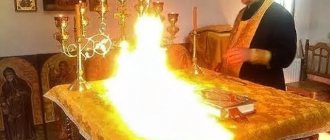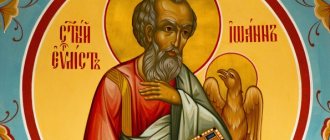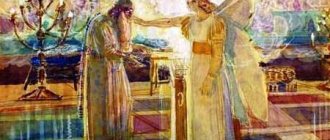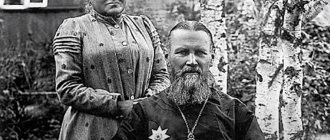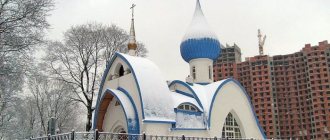Biography of John of Kronstadt
John of Kronstadt (John Ilyich Sergiev) is one of the most famous Orthodox figures of the 19th century, a hereditary priest who served as rector of the Cathedral of St. Andrew the First-Called for more than half a century, a miracle worker and a righteous man who completely devoted himself to serving his neighbors, an ascetic with a spirit of asceticism, canonized among the righteous.
In the photo: John of Kronstadt
The idol of the “city bottom,” called by Western media “the uncrowned Russian Pope,” was a staunch monarchist, an opponent of the revolutionary movement and Leo Tolstoy.
The daily routine of the righteous
During the Divine Liturgy celebrated in Kronstadt St. Andrew's Cathedral.
right John of Kronstadt. Photo from the site hamburg-hram.de For a person in demand by society, the question always arises: how to manage everything? How to structure your day to get at least the most important things done? The working day is right. John of Kronstadt began with prayer. First – personal, then – church.
Fr. got up. John at three o'clock in the morning and was preparing to serve the Divine Liturgy. At about four o'clock he went to the cathedral for matins. Here he was already met by crowds of pilgrims eager for blessing. There were also many beggars there, to whom Fr. John gave alms.
Before the start of the liturgy there was confession. Due to the enormous number of people who wanted to confess to Fr. John, they introduced, out of necessity, general confession.
This confession made a stunning impression on all participants and eyewitnesses: many repented out loud, loudly shouting out their sins without shame or embarrassment.
St. Andrew's Cathedral, which could accommodate up to five thousand people, was full every day, communion took a very long time, and the liturgy did not end before 12 noon. Service o. Joanna represented a continuous, fervent prayerful outburst to God.
During the service Fr. John was a mediator between God and people, an intercessor for their sins, a living link connecting the earthly Church, for which he interceded, and the Heavenly Church, with whose members he prayerfully communicated in spirit.
Father John with his sisters Anna and Daria, who remained in Sura. Father John constantly helped their families financially. Sura, 1891. Photo from the site mir.zavantag.com
Reading about. John on the choir was also a living conversation with God and with His saints: he read loudly, clearly, soulfully. During the Divine Liturgy, tears flowed from his eyes, but he did not notice them: the entire history of man’s salvation, God’s suffering for man’s sins, and the suffering of man himself were experienced directly by him.
Such service had an extraordinary effect on everyone present. Not everyone went to Fr. John with firm faith: some - with doubt, distrust, others - out of curiosity. But, having attended at least once the service of Fr. John's liturgy, unbelievers were completely transformed, doubters were strengthened. There were always so many people taking communion after general confession that sometimes there were several large Chalices on the holy altar, from which the priests would commune to the faithful at the same time. And such communion often lasted more than two hours.
During the service, letters and telegrams were brought to Fr. John directly to the altar, and he immediately read them and prayed for those whom they asked to remember.
After the service, accompanied by thousands of believers, Fr. John left the cathedral and went to St. Petersburg on countless calls to the sick. And he rarely returned home before midnight. Considering that at three o'clock in the morning Fr. John was already on his feet; apparently, he had not slept at all for many nights.
Of course, it was possible to live and serve like this only with the presence of God’s gracious help, given in prayer.
Childhood and youth
The future righteous saint was born on October 31, 1829 in the north of the country in the village of Sura, Arkhangelsk province, into a family of poor and deeply religious people.
My husband's ancestors and relatives were clergy for many generations. The child, born very weak, was on the verge of life and death. The parents, clerk of the local church Ilya Mikhailovich and his wife Feodora Vlasyevna, feared that their first-born would not live to see the morning, so they immediately baptized him. Later, their family was replenished with three boys and two girls. But only Ioanna’s sisters survived, while the brothers all passed away: two in infancy, and one at the age of 18 from tuberculosis.
Icons of John of Kronstadt
Since childhood, Vanya often attended church with his father. He grew up as a sickly, calm and God-fearing child, showing ardent sympathy for the poor, beggars and all those suffering who came to the temple for consolation.
Notes
- the city of Kronstadt is
- ↑. Retrieved April 27, 2022.
- . Electronic fund of legal and regulatory technical documentation
. Retrieved November 18, 2022. - Darinsky A.V.
Geography of Leningrad. - L.: Lenizdat, 1982. - P. 12-18. - ↑ St. Petersburg: Encyclopedia. - M.: Russian Political Encyclopedia, 2006.
- ↑ Darinsky A.V.
Geography of Leningrad. - L.: Lenizdat, 1982. - P. 21-29. - Meteorological map // Atlas of the Leningrad region. - M.: GUGK under the Council of Ministers of the USSR, 1967. - P. 20-24.
- . Weather and Climate
. Retrieved November 18, 2022. - Hunting animals, birds and fish // Atlas of the Leningrad Region. - M.: GUGK under the Council of Ministers of the USSR, 1967. - P. 36-37.
- ↑. Retrieved April 12, 2016.
- ↑. Retrieved April 23, 2015.
- .
- . Retrieved August 14, 2014.
- . Retrieved May 31, 2014.
- . Retrieved November 16, 2013.
- . Retrieved August 2, 2014.
- . Retrieved August 6, 2015.
- (July 31, 2017). Retrieved July 31, 2022.
- . Retrieved July 25, 2022.
- Toponymic encyclopedia of St. Petersburg. - St. Petersburg: Information and Publishing Agency LIK, 2002.
- . www.kronstadt.ru. Retrieved November 18, 2022.
- ↑. samlib.ru. Retrieved November 18, 2022.
- . www.kronstadt.ru. Retrieved November 18, 2022.
- Georgi I.G.
Description of the Russian-imperial capital city of SAINT PETERSBURG and attractions in its vicinity, with a plan. - St. Petersburg: League, 1996. - S. Malakhov.
. www.kaponir.ru. Retrieved March 8, 2022. - Converted into a floating battery, and then a training ship, since 1950 bearing the name "Volkhov"
- .
- . RIA Novosti (June 2, 2019).
- . TV channel “Zvezda” (June 6, 2019).
- . TASS (June 2, 2019).
- P. Winkler.
Coats of arms of cities, provinces, regions and towns of the Russian Empire, included in the Complete Collection of Laws from 1649 to 1900. - St. Petersburg, 1899. - ↑. www.heraldicum.ru. Retrieved November 18, 2022.
- , With. 34.
- ↑
- Online media kronnews.ru.
.
Online publication kronnews.ru
(April 14, 2016). - Blaug M.
Tuck, Thomas // 100 great economists before Keynes = Great Economists before Keynes: An introduction to the lives & works of one hundred great economists of the past. - St. Petersburg: Economics, 2008. - pp. 296-298. — 352 p. — (Library of the “Economic School”, issue 42). — 1,500 copies. — ISBN 978-5-903816-01-9. - (unavailable link). Retrieved January 18, 2022.
- ↑
Stolpyansky P.N. kronstadt.ru. Retrieved August 1, 2022. - See SZRI, No. 6719
- Stolpyansky P.
N. kronstadt.ru. Retrieved August 1, 2022. - Nina Petlyanova.
(unavailable link). // novayagazeta.ru. Retrieved August 23, 2011. - . Foundation for Assistance for Internet Technologies and Infrastructure Development
. Retrieved November 18, 2022. - . www.spbtvradio.narod.ru. Retrieved November 18, 2022.
- ↑ This settlement is located on the territory of the Crimean Peninsula, most of which is the subject of territorial disputes between Russia, which controls the disputed territory, and Ukraine, within whose internationally recognized borders the disputed territory is located. According to the federal structure of Russia, on the disputed territory of Crimea there are constituent entities of the Russian Federation - the Republic of Crimea and the federal city of Sevastopol. According to the administrative division of Ukraine, on the disputed territory of Crimea there are regions of Ukraine - the Autonomous Republic of Crimea and the city with a special status of Sevastopol.
- https://upload.wikimedia.org/wikipedia/commons/f/fc/RR5714-0024R.jpg
- . yandex.ru. Retrieved November 18, 2022.
- . SuperMonetki.ru. Retrieved November 18, 2022.
Studies
At the age of 6, Ivan, on the instructions of his father, began to study literacy, which was given to him with great difficulty.
Then the boy began to tearfully ask the Lord for help. One night, after fervent prayers, a guardian angel came to him. The kind spirit reassured the child and promised to protect him from all troubles. From that moment on, the situation changed, and Ivan became a capable student, learning all the wisdom on the fly. The family lived poorly, but the relatives managed to find funds and send ten-year-old Ivan to the parish theological school in Arkhangelsk. He was a self-sufficient student (that is, he lived on his own), but became one of the best graduates, although he was forced to lead a half-starved lifestyle. Then he continued his studies at the local seminary, and upon graduation in 1851 he became a state-paid student (that is, supported by the state) of the Theological Academy of the city on the Neva. After 4 years, the young man completed his studies, receiving the right to call himself a theologian.
John of Kronstadt
In 1851 his father died. The young man wanted to leave his studies to take the place of deacon and support his mother. However, she did not allow him to quit his studies. And then Ivan simultaneously got a clerical job and sent all his earnings home.
Literature
- Gusarov A. Yu.
Monuments of military glory of St. Petersburg. - St. Petersburg: Paritet, 2010. - 396 p. — 3,000 copies. — ISBN 978-5-93437-363-5. - Gusarov A. Yu.
Petersburg - the capital of fountains: A guide to the fountains of St. Petersburg. - St. Petersburg: State Unitary Enterprise "Vodokanal of St. Petersburg", 2008. - 189 p. — 3,000 copies. — ISBN 978-5-901751-87-9. - Dorogov N. N.
Historical essay and description of Kronstadt. - SPb.: type. Morsk. m-va, 1908. - 19 p. - (11th International Shipping Congress. - St. Petersburg, 1908. - Collection of brief information on the maritime department). - Elagin S.I.
The beginning of Kronstadt // Kronstadt Bulletin. - 1866. - No. 1, 3, 5, 6. - History of the Kronstadt Hospital: To the 250th anniversary of its founding: / Rep. ed.: E. M. Ivanov. - L., 1967. - 283 p.
- Krestyaninov V. Ya.
Kronstadt: Fortress, city, port. - St. Petersburg: Ostrov, 2002. - 160 p. - Lebedev A. A.
Little-known moments of the Russian-English crisis of 1791 // Gangut. - 2015. - No. 89-90. - Petrov G. F.
Kronstadt: Essay on the history of the city. — 2nd ed., revised. and additional - L.: Lenizdat, 1985. - 333 p. — 5,000 copies. - Ragozina E. B., Mayorov N. E.
On the history of the Kronstadt Order of Lenin Marine Plant: 1858-1958. - L., 1958. - 195 p. - Razdolgin A. A., Skorikov Yu. A.
Kronstadt Fortress. - L.: Stroyizdat, 1988. - 419 p. — 50,000 copies. — ISBN 5-274-00232-3. - Rozadeev B. A., Somina R. A., Kleshcheva L. S.
Kronstadt: Arch. feature article. - L.: Stroyizdat, 1977. - 143 p. — 20,000 copies. - Rykachev N.A.
Kronstadt antiquity // Kronstadt Bulletin. - 1884. - No. 136, 150.; . - 1885. - No. 40. - Stolpyansky P.N.
Historical and social guide to Kronstadt. - SPb.: State. ed., 1923. - 148 p. - Timofeevsky F.A.
A brief historical sketch of the bicentennial of the city of Kronstadt. — Kronstadt: type. t-va Kronshtd. Vestn., 1913. - 288 p. - Shelov A.V.
Historical sketch of the Kronstadt fortress. — Kronstadt: type. gas. "Kotlin", 1904. - 236 p. - Sarychev, Alexey Andreevich // General Marine List: in 12 volumes.. - St. Petersburg. : Type. Naval Ministry in the Main Admiralty, 1890. - Vol. 5: Part V. The reign of Catherine II. S - Ѳ. — P. 33-34. — 474 p.
Service
After receiving higher spiritual education, the young theologian intended to become a monk and missionary in order to convert pagan peoples to Christianity. But seeing that he would be useful in his small homeland for solving educational problems, fighting atheism and revolutionary activity, he decided to stay.
Diary of John of Kronstadt “My life in Christ”
He was offered a position as a clergyman in St. Andrew's Cathedral in Kronstadt. When he first entered it, he was shocked by what he saw. It turned out that he had already seen it - in a dream.
In 1855 John was ordained a deacon and then a priest. In 1857 he began teaching, first at a local school, and in the period 1862-1887. - in the gymnasium.
Priest John of Kronstadt
The port city was at that time a place of administrative expulsion of antisocial elements, including beggars and criminals. The young priest began to support these people rejected by society, visiting their homes, helping to care for the infirm. He slept no more than four hours a day, prayed fervently and celebrated the liturgy daily.
John of Kronstadt with parishioners
At first, people did not believe in his pure thoughts, did not sincerely perceive the priest’s emotionality and tears that seemed feigned to them. They even mocked his altruism, and the management began to give his salary to his wife - out of fear that he would immediately give all the money to the poor. However, soon no one could doubt the sincerity of the servant of God and his sacrificial and active love.
Prayer to John of Kronstadt
At the age of 38, the holy father acquired the gift of working miracles. Thanks to the power of God, he began to heal serious illnesses with prayer. So he healed a demon-possessed woman and caused rain in an area affected by drought. The fame of the abilities of the Kronstadt holy healer spread throughout the country and beyond. He healed the sick even from a distance. Hundreds of letters and telegrams were sent to him to get help.
In 1875, John of Kronstadt received the rank of archpriest, in 1894 - rector of the temple, in 1899 he was awarded the right to wear a miter for special merits, and became an honorary member of the Russian St. Prince Vladimir Brotherhood in Germany.
Book of John of Kronstadt
Along with the fame of the miracle worker, donations to the temple and his opportunities for charity increased. The mitred archpriest, who had a sum of about one million a year, not only went to the homes of his parishioners and distributed help, but also fed about a thousand beggars every day, created a “House of Diligence” to introduce those in need to work, founded an orphanage, a school with workshops , an almshouse for disabled women. In his homeland, he built a church and a monastery, and also became the creator of a monastery in the Northern capital on Karpovka.
The “All-Russian Father” often traveled around the country. And wherever he appeared, he was accompanied by crowds of thousands of admirers. When in 1890 he held a service in the Kharkov Cathedral, more than 60 thousand believers gathered at the temple. He received similar receptions in Moscow, Riga, and Kazan.
All-Russian Father. Father John of Kronstadt
The righteous man kept a personal spiritual diary, published in 1893 as the book “My Life in Christ,” which was later translated into several foreign languages.
In 1894, the “Elder of Kronstadt,” who considered autocracy a religious and political ideal, visited the dying autocrat Alexander III in Crimea. After this visit, his popularity increased even more. He also participated in the liturgy on the occasion of the coronation of Nicholas II.
Convent of John of Kronstadt
The Holy Father was a member of the Kazan Temperance Society, the Black Hundred monarchist organization “Union of the Russian People”, and was indignant towards atheists, the revolutionary intelligentsia, and freethinkers who undermined people’s faith in the system that had existed for thousands of years. He also criticized Leo Tolstoy, who, according to him, perverted the very meaning of Christianity. Negative assessments of the archpriest's speeches against Tolstoy and the socialists appeared in the media.
Memory
- I wrote an akathist to the righteous youth Artemy Verkolsky.
- 1894 – “My life in Christ, or moments of spiritual sobriety and contemplation, reverent feelings, spiritual correction and peace in God”
- 1890-1894 – “Complete Works”
- 1896 – “On the Beatitudes of the Gospel”
- 1896 – “Conversations about God the Creator and Provider of the world”
- 1899 – “Thoughts on various subjects of Christian faith and morals”
- 1897-1898 - “Words and teachings spoken in 1896, 1897 and 1898.”
- 1898 – “A few words to denounce the false teaching of Count L.N. Tolstoy”
- 1899 – “The Truth about God, the World and Man”
- 1900 – “Knowledge of God and self-knowledge acquired from experience”
- 1900 – “The truth about God, about the Church, about the world and about the human soul. From a new diary. Reflections of an Orthodox Christian"
- 1901 – “Blessed thoughts about heavenly and earthly things”
- 1902 – “A simple Gospel word to the Russian people”
- 1902 – “Christian Philosophy”
- 1905 – “Thoughts of a Christian”
- 1905 – “The Path to God”
- 1905 – “Contemplations and feelings of the Christian soul”
Family
After receiving higher education, the pastor of the Church married the daughter of the archpriest of the Kronstadt Cathedral, Elizabeth. They had no children, having taken upon themselves the feat of virginity, but they raised two daughters of the sister of his wife Anna. After his marriage, his wife’s widowed father, her three brothers and two sisters also found themselves in the care of the young husband.
John of Kronstadt and his wife Elizaveta Konstantinovna
Mother Elizabeth taught her nieces French, accompanied them to the gymnasium, and took care of the housework. Father John monitored their academic progress every day. According to the recollections of one of the adopted daughters, the pious spouses were distinguished by their touching care and attention to each other.
Attractions
The most famous architectural monument of the city is the Naval St. Nicholas Cathedral, built in 1902-1913. In addition, a number of historical buildings of the 18th-19th centuries have been preserved: the Italian Palace, “provincial” houses, the Kronstadt Admiralty complex, the walls and barracks of the Kronstadt Fortress, the Arsenal (engineer J. Whistler), Gostiny Dvor. The cast iron pavement in the city center is also of interest.
View of Petrovsky Dock from the Canal named after. Peter I the Great
Naval St. Nicholas Cathedral. August 2014
Temples
The churches of Kronstadt were not only places of worship, but were also guardians of relics of the military glory of the Russian fleet. Until 1917, the city had about 30 Orthodox churches, two Lutheran churches, one Catholic and one Old Believer, as well as a mosque and a synagogue.
- Naval St. Nicholas Cathedral
- Cathedral of the Vladimir Icon of the Mother of God
- Chapel of the Epiphany "Savior on Water"
Inactive
, photo from 1898
- St. Andrew's Cathedral (destroyed, chapel restored)
- Church of the Exaltation of the Cross - consecrated by Fr. John of Kronstadt; building of the former Anglican Church of Kronstadt.
- Church of St. Nicholas of the Estonian-Swedish-Finnish parish (demolished).
- (Lenina Ave., 5; not preserved)
- Lutheran Church of St. Elizabeth - now the building belongs to Vodokanal.
Museums
- Museum of the History of Kronstadt (historical architectural and art museum) - st. Leningradskaya, 2A
- Museum "Kronstadt Fortress" branch of the Central Naval Museum - Yakornaya Square, 2
- Memorial Museum-Office of A. S. Popov - st. Makarovskaya, 1/3
- Museum-apartment about. John of Kronstadt - st. Posadskaya, 21A
- Museum of the Kronstadt Marine Plant - Lenin Ave., 39A
- Kronstadt Maritime Museum - Andreevskaya st., 5
- Lighthouse Museum - Fort Constantine
Monuments
Monument to Admiral S. O. Makarov “remember the war”
Monument to Admiral Bellingshausen
- Monument to Peter I
- Monument to Peter I at Fort Kronshlot (“Sovereign Founder”)
- Monument to A. S. Popov
- Monument to P.K. Pakhtusov
- Monument to F. F. Bellingshausen
- Monument to S. O. Makarov
- Monument to F. F. Ushakov
- Monument to P. L. Kapitsa
- Monument to midshipman A. A. Domashenko
- Monument to the crew of the clipper "Oprichnik"
- Ivan Tambasov's gun
- Monument to Seafarers
- Monument to Submariners
- Memorial "Fighters for the Cause of the Revolution"
- Memorial to those killed in the Great Patriotic War
- Memorial ""
- Memorial to the Baltic Submariners
- Memorial "150th anniversary of the establishment of Russian-Japanese diplomatic relations"
- Monument to the revolutionary sailors of the Baltic (P. E. Dybenko)
- Monument to S. M. Kirov
- Monument to I.K. Aivazovsky
- Monument to the Siege Stickleback
- Monument to the bowler
- Monument to V.I. Lenin
- Monument to John of Kronstadt
- Monument "Cat and Dog". Material: wood.
Forts
See also: Forts of St. Petersburg
Southern Forts
Kronstadt. Fort "Emperor Alexander I". Aivazovsky I.K. 1844
- Fort No. 1
- Fort No. 2 (“Dzichkanets”)
- Fort No. 3 (“Count Milyutin”)
- Fort "Paul I" (Risbank)
- Fort "Kronshlot"
- Fort "Peter I" ("Citadel")
- Fort "Alexander I" ("Chumny")
- Fort "Grand Duke Constantine"
- Battery "Prince Menshikov"
North Fort
Northern forts
- Fort No. 1
- Fort No. 2
- Fort No. 3
- Fort No. 4 (“Zverev”)
- Fort No. 5
- Fort No. 6
- Fort No. 7
- Fort "Totleben"
- Fort "Obruchev"
- Gunpowder Fort
Forts on the island Kotlin
- Fort "Shants" (Shanets) ("Alexander-Shants")
- Fort "Reef"
Cultural heritage sites and other attractions
Anchor Square. St. Nicholas Naval Cathedral, monument to S. O. Makarov and the Eternal Flame (from left to right)
- Italian Palace
- Water tower. Built in 1926. (Kronstadt)
- Gostiny Dvor
- Fortress wall
- Lighthouse Tolbukhin
- Footstock
- Dam
- Blue Bridge over the Obvodny Canal
| Cultural heritage site, object No. 7801969000 object No. 7801969000 |
- Dock Bridge
- Hemp Bridge over the Obvodny Canal
| Cultural heritage site, object No. 7801970000 object No. 7801970000 |
Hemp Small Suspension Bridge
| Cultural heritage site, object No. 7801971000 object No. 7801971000 |
Abutments of the underground bridge across the Obvodny Canal
| Cultural heritage site, object No. 7801972000 object No. 7801972000 |
Makarovsky Bridge over Petrovsky Ravine
| Cultural heritage site, object No. 7801973000 object No. 7801973000 |
Hemp Small Suspension Bridge
| Cultural heritage site, object No. 7801971000 object No. 7801971000 |
Anchor Square
Death
In recent years, the holy father suffered from a painful bladder disease, but he never complained to anyone.
The health of his wife also deteriorated, and when asked about his health, John simply answered that they were both preparing for death. The righteous saint knew in advance about the day of his departure from life. In November 1908, his wife, to encourage him, said that he would get better in the spring, since he usually felt better with the arrival of spring. But he objected, noting that she would live until spring, but he would not.
Funeral of John of Kronstadt
And so it happened. John of Kronstadt performed his last liturgy on December 9, and on the 20th he passed away. The saint was buried with great honors and a military orchestra in the temple-tomb of the monastery on Karpovka.
Tomb of John of Kronstadt
The canonization of John of Kronstadt was carried out twice: in 1964 by the Russian Orthodox Church Abroad and in 1990 by the Moscow Patriarchate.
Data
- The city has preserved the only circular cast-iron pavement in the world.
- When Yuri Gagarin was shown the famous measuring post with a foot rod, the level of which was taken to be zero sea level, he exclaimed: “Now I know where the navel of the Earth is!”
- 41 round-the-world expeditions were completed and dispatched in Kronstadt, and 56 major geographical discoveries were made by the crews of ships assigned to Kronstadt.
- Until the end of the 80s. In the 20th century, there was an extensive network of fortress railways on the island, which connected the forts with ammunition depots, the port and the Marine Factory. During the Great Patriotic War, an armored train was formed in Kronstadt.
- Several coins dedicated to Kronstadt have been issued.
- 2013 10 rubles Kronstadt (DHW)
- 2013 3 rubles St. Nicholas Naval Cathedral (silver)
- 2013 1 1/2 ruble souvenir coin
- 2009 Souvenir coin
- 2003 1,000 ruble (gold)
- 1981 200 USSR rubles (trial series)
What did he say about Russia?
John of Kronstadt, whose relics are kept in St. Petersburg in the Ioannovsky Monastery, was famous for his gift of predictions. He foresaw that Russia would face difficulties in the future. John believed that if rebels and rebels were not driven out of the state, then people who would despise faith in God would soon come to power.
And if Russia refuses the Lord, then it will soon lose the King of Heaven, and the once great state will fall and crumble into small fragments. He also easily exposed robbers, liberals, nihilists, and socialists. For this, the authorities hated him.
The relics in St. Petersburg are kept in the Ioannovsky Monastery
One day he was lured into a mansion by cunning, crucified and stabbed several times with a sharp object directly in the groin. John of Kronstadt, whose birthday is October 10, chose to hide this crime because he feared pogroms, because the criminals were non-Russian people.
Donations
Thousands of people turned to John of Kronshadt, whose grave is in St. Petersburg, for help. In addition, they began to donate huge sums of money to him, which he spent on the construction of temples, hospitals, schools, churches, and charity.
The grave is located in St. Petersburg
In one day, thousands of beggars came to John of Kronstadt (few know where the benefactor is buried), to whom he gave 20 kopecks. This money was enough for lunch, dinner and overnight stay. According to some reports, about 1 million rubles passed through his hands annually. in year.
Towards the end of the 19th century, John of Kronstadt (you can learn more about his life from the video) no longer had the opportunity to serve such a number of pilgrims. He decided to hire a staff of employees who made a good fortune for themselves by deceiving people who turned to them for help.
It is also known that John is the man who saw the death of the ruler Alexander III. Moreover, a few hours before his death, he anointed him with oil and held his head in his hands until the emperor died.
Soon John of Kronstadt, whose icon is of great importance for the Orthodox, began to fear his glory. After all, it became difficult to move due to the huge number of Christians pursuing him, and something always threatened the safety of his benefactor.
Prayer with the sovereign
John of Kronstadt conducts a memorial service for Alexander III in the Small Palace in Livadia.
1866 Drawing from the website hranitel.club In October 1894, Father John was summoned to the royal palace in Livadia, where Emperor Alexander III was dying. Father John was called to pray for the health of the seriously ill Emperor.
The Emperor met Fr. John with the words: “I did not dare to invite you myself. Thank you for coming. Please pray for me, I’m not feeling well.”
After the joint kneeling prayer of the Sovereign alone with Fr. John saw a significant improvement in the patient’s health, and hopes arose for a complete recovery. This went on for five days; On October 17, deterioration began again, and on this day the Emperor was honored to receive the Holy Mysteries for the second time from the hands of Father John of Kronstadt.
“I did not consider my mission accomplished,” said Fr. John, until I myself give communion to the tall sick man. I myself am in dire need of daily communion of the Holy Mysteries and consider it a great deprivation if I do not receive communion; Likewise, a sick person needs this all-reviving sacrament, if not every day, then after a certain interval, and I, having served the liturgy on October 17 in the presence of the Highest Persons, went with the Cup of Life along with the protodeacon in a carriage to the palace to the sick person.
Entering its premises with the Holy Chalice, I said aloud the words from the church song: “Behold, the King of glory enters, behold, the secret sacrifice is completely delivered, let us approach with faith and love, so that we will be partakers of eternal life.” The Emperor received great consolation from the grace of Christ.
In the last hours of his life, the Emperor spoke of Fr. John: “You are a holy man. You are righteous. That's why the Russian people love you.
“Yes,” answered Fr. John, “your people love me.” “He loves,” answered the Emperor, “because he knows who you are and what you are” (his true words).
Dying, the Emperor asked Fr. John to lay his hands on his head, telling him: “When you keep your hands on my head, I feel great relief, but when you take them away, I suffer greatly - do not take them away.”
Father John continued to hold his hands on the head of the dying king until the king gave up his soul to God.
